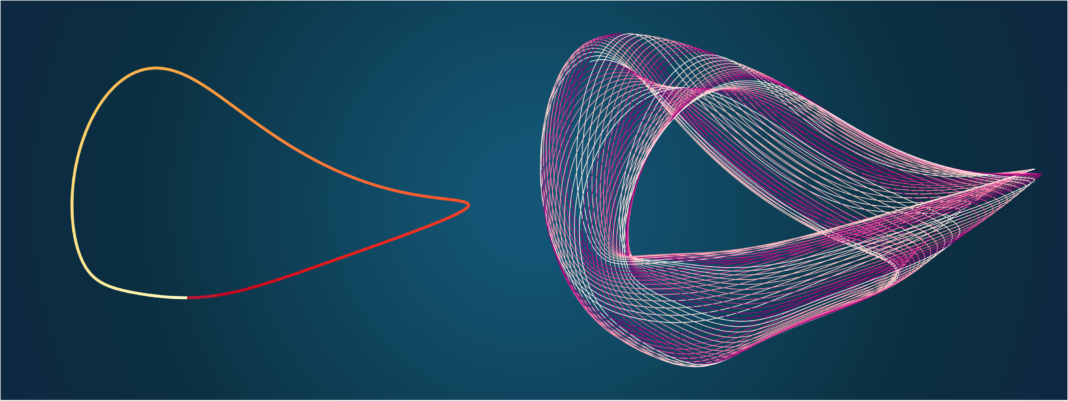By Harvey Sapigao
Imagine a very thin rubber band morphing into a donut. This transformation, known as the ‘birth of a torus’, is used to mathematically describe the behavior of systems undergoing transitions. While the birth of a torus is common in classical systems, it has only existed theoretically in quantum systems—until now. An international team led by UP physicist Dr. Jayson Cosme has experimentally observed this phenomenon in quantum systems for the first time, using lasers, mirrors, and time crystals.
Many repeating behaviors in nature can be described by shapes such as a rubber band or a donut. One example is the beating of the heart, which cycles between “lub” and “dub.” Scientists can visualize this cycle by drawing a two-dimensional loop in a mathematical space called the phase space. This loop represents all of the heart’s states: lub corresponds to one side of the loop, while dub corresponds to the other. This lub-dub loop captures the behavior of a stable heart, but when the beating becomes irregular, more complex shapes are needed to represent the behavior more accurately—like a donut, or more formally, a torus.
Quantum systems also exhibit repeating behaviors that can be mapped in the phase space. One such system is the time crystal, or ultra-cold atoms that switch back and forth between two states over time. Like the rhythm of a heartbeat, time crystals can be represented by a loop in the phase space. Physicists created the first time crystals in 2016 by shining a pulsating laser on ultra-cold atoms. The laser’s rhythmic pulses cause the atoms to cycle between two states.
In 2022, Dr. Cosme of the UP Diliman College of Science National Institute of Physics (UPD-CS NIP), together with physicists in Germany, showed that time crystals can form even without a pulsating laser. They sandwiched ultra-cold rubidium atoms between two highly reflective mirrors and directed a laser onto the setup. The mirrors repeatedly reflected the laser, effectively trapping it and forcing it to interact continuously with the rubidium atoms.
The team adjusted the laser’s brightness and observed how the atoms responded. They found that when the laser reached a specific intensity, the atoms began oscillating between two states, becoming time crystals. The physicists called it a “continuous time crystal,” marking the first experimental realization of its kind.
Now, using the same experimental setup and working with the same collaborators, the team has taken the idea even further. “In this new study, we showed that cranking up the intensity of light to even brighter or stronger levels will lead to another critical transition,” said Dr. Cosme.
When exposed to a stronger laser, the time crystal begins to behave in a way that can no longer be accurately described by a simple loop in the phase space. Instead of switching periodically between two states, it starts oscillating in an unstable, more complex manner. Its representation in the phase space transforms from a loop to a torus — the birth of a torus.
The time crystal’s extreme sensitivity to light made this transition difficult to observe. Still, the team’s cold atom experiment was exceptionally precise, allowing it to capture the transition for the first time in history. Their study is now published in the prestigious journal Physical Review Letters.
Beyond fundamental physics, the findings could pave the way for new kinds of ultra-sensitive light detectors. “The transition between loop and torus depends on the light intensity,” explained Dr. Cosme. “Below the critical point, it will be a loop, while above, it will be a torus. As such, a system operating close to this transition point can be used as a sensitive detector for light or electromagnetic fields.”
The team is now investigating whether bifurcations in quantum systems can be predicted before they occur. They also plan to use their experimental setup to explore other quantum phenomena, such as the Kibble-Zurek mechanism, which they examined in a paper published last year. “We’re quite excited about that one, and we hope we can share some exciting news about it soon,” concluded Dr. Cosme.
For interview requests and other concerns, please contact media@science.upd.edu.ph.
References:
Cosme, J. G., Kongkhambut, P., Bölian, A., Tuquero, R. J. L., Skulte, J., Mathey, L., Hemmerich, A., & Keßler, H. (2025). Torus bifurcation of a dissipative time crystal. Physical Review Letters, 134(22). https://doi.org/10.1103/physrevlett.134.223601




